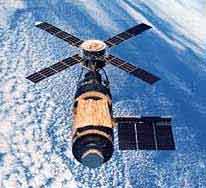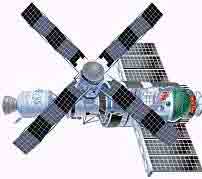|
   
> History
> Space Craft
> Unmanned Space Programs
> Animals in Space
> Human in Space
> Human in Moon
> Manned Space Programs
> Space Station
> Voyager 1
> Voyager 2
> Hubble Space Telescope
> Recent & Future Developments
       
|
Salyut and Skylab were
the first spacecraft designed as space stations, orbiting the Earth for
extended periods while crews came and went on other vehicles. Many
valuable new experiments and astronomical observations could now be
performed.
Soviet Stations
The Soviet Salyut 1 space station, weighing 18,600 kg
(41,000 lb), was launched on April 19, 1971. Three days later Soyuz 10,
with a crew of three cosmonauts, rendezvoused and docked with Salyut. For
some unspecified reason, however, the cosmonauts did not enter the space
station but undocked and returned to Earth. In June Soyuz 11 joined with
Salyut 1, and the three-man crew moved into the station to set a
manned-flight duration record of 24 days. A large number of
Earth-resources and biological experiments were conducted. During the
return journey to Earth, however, tragedy struck, and upon landing the
three cosmonauts—Georgi T. Dobrovolsky, Vladislav N. Volkov, and Viktor I.
Patsayev—were found to be dead, victims of an air leak in a valve. Because
they wore no space suits, the cosmonauts had died quickly. The Soviet
programme then suffered another setback. The Salyut 2 space station, which
was launched in April 1973, apparently went out of control, shedding
various parts in orbit.
Thereafter, however, the Soviet Union sent up Salyut 3 (June 1974-January
1975), 4 (December 1974-February 1977), and 5 (June 1976-August 1977).
Salyut 6 (September 1977-July 1982) and 7 (April 1982- ) were visited by a
large number of international crews, including Cuban, French, and Indian
cosmonauts and the first woman to perform extravehicular activity,
Svetlana Savitskaya, during the flight of Soyuz T12 on July 17-29, 1984.
One of the most notable flights of the Salyut/Soyuz series occurred in
1984 when cosmonauts Leonid Kizim, Vladimir Solovyov, and Oleg Atkov,
spent 237 days aboard the Salyut 7 before returning to Earth, the longest
space flight to that date. Salyut 7, now abandoned, remains in orbit.
The Mir space station, which the Soviets designed as a successor to the
Salyut series, was launched on February 19, 1986. Described by the Soviets
as the core of the first permanently staffed space station, it featured
six docking ports and could accommodate two cosmonauts. In 1987, Colonel
Yuri Romanenko spent 326 days aboard Mir, the longest space flight then on
record. On April 12, 1987, the Soviets succeeded in docking Mir with Kvant,
an 18,000-kg (40,000-lb) astrophysics module. Carrying four X-ray
telescopes, Kvant was designed to observe a supernova that had recently
exploded in a nearby galaxy, the Large Magellanic Cloud. X-rays from the
exploding star, which were blocked by the Earth’s atmosphere, could be
detected from Kvant. In 1987-1988, Soviet cosmonauts Vladimir Titov and
Musa Manarov set a new record for time spent in space—366 days.
In mid-1997, however, Mir was struck by a series of grave mishaps. On June
25, an unmanned Progress supply vessel collided with the Spektr module,
part of Mir, while docking manoeuvres were being practised. There was a
loss of power and air pressure on the station, which the crew were able to
rectify. On July 17 a power cable was accidentally unplugged, and the
station lost attitude control. Since its solar arrays were then no longer
directed towards the Sun, the station lost power. It took several days to
solve this problem. The crew's tiredness and the discovery of an
irregularity in the commander's heartbeat led to the planned major repairs
being postponed until a relief crew could take over. Following these
problems, and given the growing expense of maintaining the space station,
it was finally decided to abandon the project. The last Mir crew,
including Sergei Avdeyev, who had set the latest record for time in space,
at 742 days, returned to Earth on August 28, 1999, and the station itself
was brought down over the Pacific Ocean, burning up and disintegrating
upon re-entry, on March 23, 2001. Russian efforts would thereafter focus
on the International Space Station currently being built in space.
[Top] US Stations
The US Skylab programme was much more extensive and
complex than the Soviet Salyut programme. Skylab, launched by the first
two stages of a Saturn 5 rocket, weighed 88,900 kg (196,000 lb) compared
with the 18,600-kg (41,000-lb) Salyut. In contrast to the estimated 99-cu
m (3,500-cu ft) interior space of Salyut, Skylab had 357 cu m (12,600 cu
ft), about 3.5 times greater. Skylab served as a laboratory in Earth
orbit. It was used to make observations of the Sun, long-duration medical
studies of the three-person crew, extensive multispectral observations of
the Earth, and a variety of scientific and technological experiments, such
as metallic-crystal growth in the weightless state.
 |
Skylab from Above
Skylab 4 astronauts took this photograph of
the United States Skylab space station over the cloud-covered Earth
from their Apollo spacecraft as they prepared to return home on
February 8, 1974. The sheet of gold-coloured material stretched over
the station is a makeshift sun shield that the astronauts of Skylab
2 set up to replace a sun and micro-meteoroid shield that fell off
during launch. As the shield fell, it knocked loose a wing-like
array of electricity-producing solar panels that was supposed to be
in the same position on the left as the remaining array is on the
right. Skylab operated for six years. |
Skylab was damaged during launch on May 25, 1973, but the crew, veteran
astronaut Conrad, Commander Joseph P. Kerwin, and Commander Paul J. Weitz,
all of the navy, carried out EVA repairs, erected a heat-shielding canopy
over the exterior of the spacecraft, and freed a jammed solar panel. Their
flight lasted 28 days. A second crew spent 59 days in orbit and the third
and final crew, 84 days. The Skylab project was considered a complete
success. More than 740 hours were spent in observing the Sun with
telescopes, and 175,000 solar images were returned to Earth, as were about
64 km (40 mi) of electronic data tape and 46,000 photographs of the
Earth’s surface. On July 11, 1979, during orbit number 34,981, Skylab
plunged to Earth, raining fiery debris over sparsely populated western
Australia and over the Indian Ocean.
 |
Skylab Space Station
In 1973 and 1974 the Skylab space station
supported three crews of three astronauts each for periods of up to
84 days. Skylab was as large as a small two-bedroom house, contained
extensive sanitary facilities, and usually maintained a constant
temperature. Skylab astronauts were able to perform many scientific
experiments in this environment. Many experiments on the effects of
weightlessness were conducted, and astronauts studied the Earth and
Sun with the telescope and infrared spectrometer. Solar panels
provided the electricity needed to run the station. |
[Top] International
Space Station
In 1988 President Ronald Reagan gave approval for a new
Space Station, called Freedom, to be built, in cooperation with several
members of the European Space Agency, Canada, and Japan. It was designed
to be the largest structure yet put into space, but to be assembled in
orbit from separately launched components. Although plans for the station
had begun in 1975, it was redesigned several times in the years following
the official go-ahead, in response to progressive budget cuts. In 1993 the
design named Alpha was chosen from among those submitted by three
different NASA centres. It was later renamed the International Space
Station (ISS) after Russia became a project partner, agreeing to supply
many of the station modules and crew members. The European Space Agency
originally intended to build a small shuttle, Hermes, for its astronauts
working at the station, but that project was abandoned in 1992 owing to
financial and technical problems. Separate modules for the station were
built by the ESA (Columbus) and Japan (the Japanese Experiment Module).
Assembly of the ISS in space began in 1998 with the launch of the first
module, the Russian Zarya, by a Proton rocket in November, and the US
Unity, a docking node, which was connected to Zarya during a spacewalk on
shuttle mission STS-88 in December. The first long-stay crew boarded the
space station on November 2, 2000, and were relieved on March 14, 2001.
Assembly is expected to be complete by 2004, after a total of 45 launches.
[Back] [Top] [Next] |

